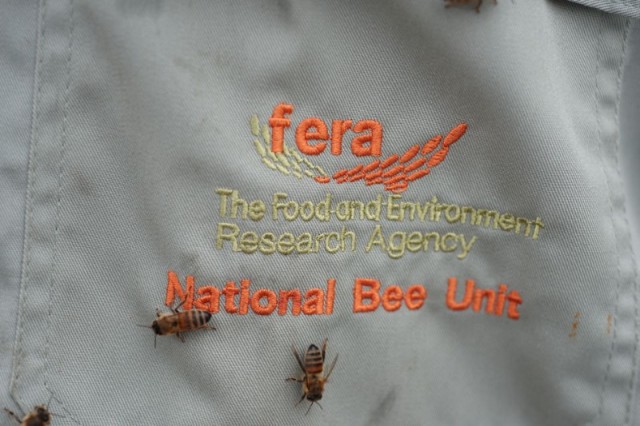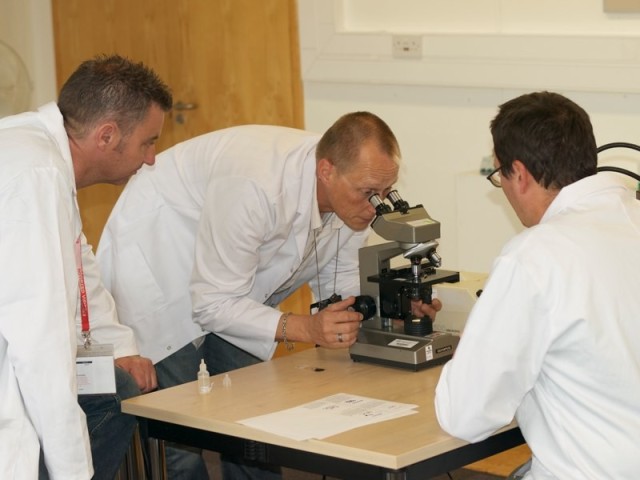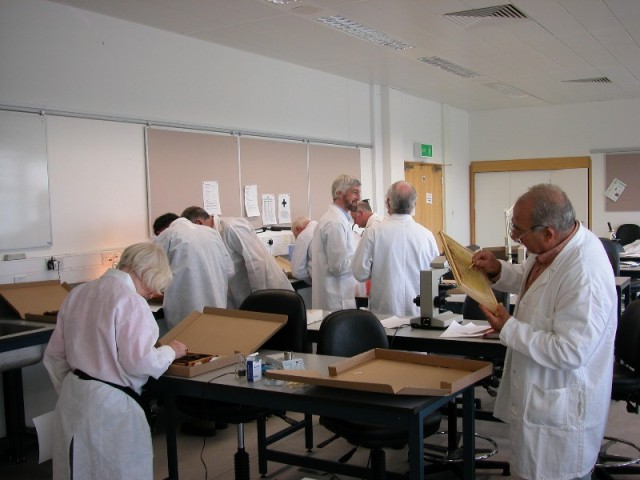An 8th revision post for the British Beekeeping Association’s Module 3 Honey bee Pests, Diseases and Poisoning exam, which I’m taking in March. I’m doing the BBKA’s correspondence course, so I have a tutor setting me papers which she then marks. I’ve just sent my answers to Paper 2 off to her, now on to Paper 3 and a look at collecting lab samples if you suspect disease or poisoning in your hives…
B1. a) what is the recommended sample size needed for the diagnosis of:
- i) adult bee diseases
30 bees must be examined in order to complete the diagnosis for acarine, nosema and amoeba.
- ii) poisoning by toxic chemicals
At least 200 dead bees are required for a full analysis for a poisoning sample, approximately the number that will fit into one of the large ‘Cooks’ matchboxes. The National Bee Unit advises that this needs “to be securely packaged, not in a plastic bag and preferably not flattened“.
Photo from the ‘How can I recycle this‘ website.
If possible, at the same time take two further samples of 200 bees and put these in the freezer in case they are needed. Note the time and day when the bees are discovered and try to locate any witnesses to spraying.
- iii) why these minimum sizes?
With a sample size of 30 bees, there is a 95% probability that acarine, amoeba and nosema will be detected within this sample, if the infection level is serious enough to require treatment.
Some beekeepers believe there is a strong case to be made for shifting our assessment of nosema infection from “intensity” (as measured by spore counts) to “prevalence” (the percentage of bees actually infected).
b) how would you collect these samples?
You want the samples to be fresh but the bees to be old…
Choose bees that are the freshest, submitting newly dead or dying bees if possible.
For some diseases, such as nosema, it is best to collect older foragers. This is because older bees have higher spore counts, since nosema in the gut multiplies and increases during an infected bee’s life. As young bees under 8 days of age won’t have any spores, sampling them could lead to “false negatives.”
Martin-Hernandez (2006) found that foragers returning to the hive can display up to 10-fold higher infection levels than interior bees, and that both interior and exterior bees had almost double the spore count when sampled at 12:30 pm rather than 8:30 am (Scientificbeekeeping.com, the ‘“Nosema Twins” – Part 3, Sampling’ article).
As well as being at the hive entrance, inside the hive foragers are more likely to be at the edges, such as the lid and outside combs. An easy way to gather these bees is to scoop them up from the inside surface of the crown board.
If bees are crawling in front of the hive entrance because they are too weak to fly, these are easy to collect and just as likely to contain nosema spores or viruses as foragers.
c) how would you kill a sample of bees for adult bee disease diagnosis at home?
Live bees can be killed by putting them in the freezer overnight.
d) how should the samples for laboratory confirmation be prepared and packed for sending by post?
- Brood disease samples
The best method is for beekeepers to submit a whole brood comb, with brood of all stages present, in order for an accurate diagnosis to be made.
- Adult bee disease samples
The best way to send in adult bee samples is in a small sturdy box, well packaged in something such as a padded envelope so the bees will not be squashed. A suitable size for the box is a standard-sized matchbox, which will contain 30 bees. Avoid using glass or plastic boxes, which will degrade the sample by hastening decomposition.
- Poisoning samples
At least 200 bees are required for a full analysis for a poisoning sample, approximately the number that will fit into one of the large ‘Cooks’ matchboxes. The National Bee Unit advises that this needs “to be securely packaged, not in a plastic bag and preferably not flattened“.
- General advice
Dry out any wet bees that have been exposed to the elements on newspaper before packing.
Indicate which diseases you want the bees examined for and include a contact phone number in case the lab has any questions about your sample. A template voluntary sample submission form can be downloaded from the National Bee Unit’s Beebase website and printed off. Information which might assist with the diagnosis should be given in a covering letter.
A cheque made payable to the Food and Environment Research Agency should be included; the 2012 price for lab analysis of a sample for Acarine, Nosema and Amoeba is £40.00, but check the National Bee Unit (NBU) prices page for current prices.
‘Bees’ written clearly in large letters on the outside of the parcel will often ensure swift delivery. You don’t have to tell the posties that the bees are dead!
e) to whom could these samples be sent?
Beekeepers in the UK can send samples to the National Bee Unit’s laboratory diagnostic team in York.

A NBU inspector’s bee suit. Courtesy The Food and Environment Research Agency (Fera), Crown Copyright
f) give a list of crops most likely to be sprayed with chemicals harmful to honeybees?
Farmers or gardeners are most likely to spray fruit trees, soft fruit and field crops such as oil seed rape, beans, borage, vegetables, legumes and cereals.
Local authorities may spray weeds such as poppy, ragwort, dandelion and charlock.
Have you ever had to submit a sample for lab analysis? How did you go about it, and what were the results?
References:
- The BBKA Guide to Beekeeping, Ivor Davis & Roger Cullum-Kenyon (2012)
- Bee diseases and their management, Edinburgh & Midlothian Beekeepers’ Association (2009)
- Effective sample gathering – making the NBU work for you, FERA (2009)
- Keeping Healthy Honey Bees, David Aston & Sally Bucknall, Northern Bee Books (2010)
- Mid Bucks Beekeepers Association, Module 3 exam notes
- National Bee Unit Beebase website
- Scientificbeekeeping.com, Randy Oliver




Your courses are really interesting and also pretty technical. I liked the view if the scientists at work.
LikeLike
Very technical, it’s a lot for my little brain to remember. Seeing all the scientists makes me envious of their official looking white coats!
LikeLike
Truthfully, they look as if they recruited them from a local retirement home, and posed them for the shots.
But, I’m not familiar with bee scientists . . . maybe they all look and act like that.
LikeLike
Harsh! (But I see what you mean!). The bee inspectors tend to be on the older side, but then it takes a good while to build up that level of knowledge. I’ve met a couple of quite handsome young entomologists before.
LikeLike
Hey, I’m old . . . I know senility when . . . what was I saying?
LikeLike
Another really useful, brilliant blog posting. Keep on keeping on. And, they don’t look all that old to me – I’d say a good mix of ages.
LikeLike
Thanks! Plenty more revision to do before my exam, I’m behind at the moment.
LikeLike
Emily, thought you and Emma might be interested. http://news.sciencemag.org/sciencenow/2010/12/video-sleepy-bees-lose-their-rhythm.html
LikeLike
I read about this, it’s amazing! I didn’t even know that bees ‘slept’ although of course this makes perfect sense. All that work they must need a quick nap!
LikeLike
It must be a recent study, I found it on Science. I am a member and if I locate the scientific paper that documents the study, I will let you know.
LikeLike
Thanks very much! I love the summary – “until the results are in, worker bees are advised to be tucked up in a hive, with a hot cup of nectar by 9 p.m.”
LikeLike
I can believe your bees do just that. 😀
LikeLike
here is a link to the paper, it’s a 2010 study
http://www.pnas.org/content/107/52/22705.full.pdf+html
LikeLike
Thanks Philip. I will be looking out for sleeping bees in my hive from now on!
LikeLike